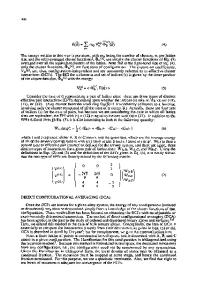Lanthanide Based Ternary Intermetallics as Advanced Thermoelectric Materials
- PDF / 248,591 Bytes
- 5 Pages / 612 x 792 pts (letter) Page_size
- 56 Downloads / 364 Views
0980-II05-44
Lanthanide Based Ternary Intermetallics as Advanced Thermoelectric Materials Ken Kurosaki, Takeyuki Sekimoto, Kenta Kawano, Hiroaki Muta, and Shinsuke Yamanaka Division of Sustainable Energy and Environmental Engineering, Osaka University, 2-1 Yamadaoka, Suita, Osaka, 565-0871, Japan
ABSTRACT Polycrystalline ingots of the lanthanide based ternary intermetallics: LaNiSb, GdNiSb, ErNiSb and ErPdSb were prepared and characterized. The thermoelectric properties of ErNiSb and ErPdSb were measured at high temperatures. We succeeded in preparing the single phase ingots of ErNiSb and ErPdSb, while the ingots of LaNiSb and GdNiSb contain appreciable quantities of the impurity phases. ErNiSb and ErPdSb crystallize the MgAgAs-type structure (half-Heusler structure). ErNiSb and ErPdSb indicate positive values of the Seebeck coefficient (S). The values at room temperature are 36 and 240 µVK-1 for ErNiSb and ErPdSb, respectively. The electrical resistivity (ρ) of ErNiSb and ErPdSb decreases with temperature, indicating semiconductor-like behavior. ErPdSb exhibits a relatively large power factor (S2/ρ): 1.5x10-3 Wm-1K-2 at around 700 K, which is approximately two times larger than that of ErNiSb. INTRODUCTION Thermoelectric materials can convert waste heat into useful electrical energy. The potential of a material for thermoelectric application is determined by a measure of the material’s figure of merit, ZT (=S2σT/κ), where S is the Seebeck coefficient, σ is the electrical conductivity, κ is the thermal conductivity, and T is the absolute temperature. Since the power factor, S2σ or S2/ρ (ρ is the electrical resistivity), is optimized as a function of carrier concentration (typically 1026 carriers/m3), almost all thermoelectric materials studied until now are semimetals and/or heavily-doped semiconductors such as Bi2Te3 and PbTe related compounds. Some intermetallics have recently received increasing attention as advanced thermoelectric materials for high temperature application. For example, a ZrNiSn based halfHeusler alloy (MgAgAs-type structure; shown in figure 1) exhibits a quite excellent thermoelectric figure of merit, ZT=1.4 at 700 K [1]. Almost all half-Heusler related intermetallics studied in the thermoelectric research field are n-type materials, in other words the Seebeck coefficient values are negative. While the high ZT value has been achieved in the n-type intermetallics, the p-type intermetallics should also be investigated. In our previous studies [2,3], it has been confirmed that the lanthanide based ternary intermetallics, LnPdX (Ln: lanthanides, X: Bi or Sb) show p-type characteristics and relatively high thermoelectric figure of merit. For example, ErPdSb with the cubic half-Heusler type structure indicates a relatively high ZT value: 0.16 at 700 K [2]; and LaPdSb crystallizes the hexagonal ZrBeSi-type structure and indicates a quite large power factor: 5.0x10-3 Wm-1K-2 [3]. However, it is preferable that the thermoelectric materials contain no palladium in order to keep the cost low.
In the p
Data Loading...










